Mastering Biscuit Recipes with Butter: The Ultimate Guide
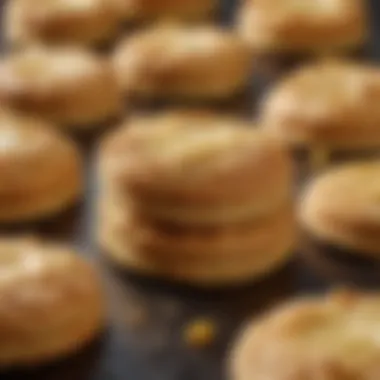
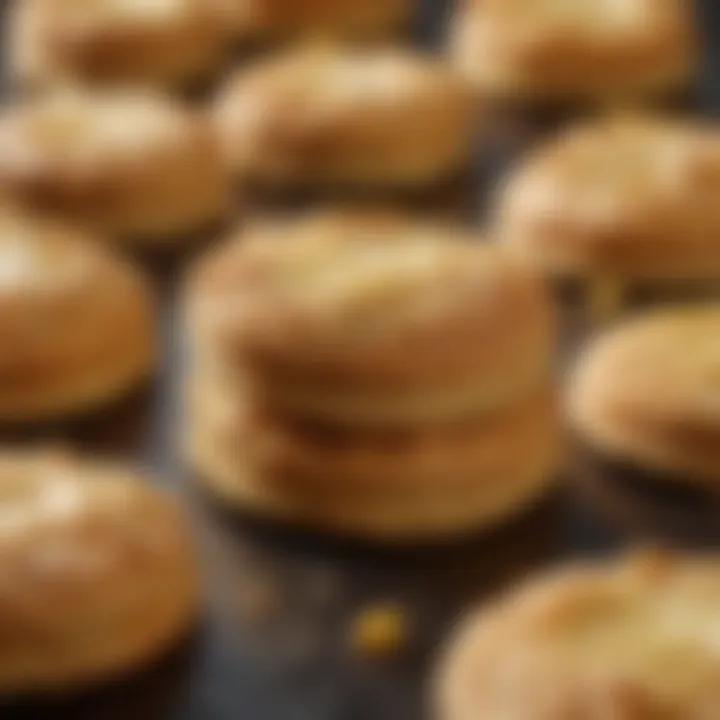
Intro
Baking biscuits often appears straightforward, but the subtleties can escalate quickly. Understanding the role of butter adds both richness and an optimum texture to these delightful baked goods. This guide will navigate through various biscuit recipes, transcending the basics to unlock the potential lying within mere flour and butter.
From busy cooks seeking quick answers to biscuit making novices, this comprehensive exploration aims to share useful strategies, tricks, and the necessary know-how. So, whether you wish for buttery scones or flaky biscuits, consider this resource an essential companion.
Recipe Highlight
Indulge in the comfort of classic Buttermilk Biscuits. A sincere example of how butter can transform texture and taste.
Essential Ingredients:
- All-purpose flour
- Unsalted butter
- Baking powder
- Buttermilk
- Salt
Preparation Time: About 20 min
Servings: Yields approximately 12 biscuits
Step-by-Step Instructions
- Preheat your oven to 450°F (230°C). Ensuring the oven is adequately heated is crucial for a proper rise.
- In a bowl, combine the all-purpose flour, baking powder, and salt. It's essential to mix dry ingredients so each biscuit lifts evenly.
- Cut cold unsalted butter into the mixture. Aim to create pea-sized crumbs. This results in a flakier texture when baked.
- Liberally fold in the buttermilk until just combined. Be gentle here; overmixing will yield tough biscuits.
- Turn the dough onto a floured surface. Knead gently for about 30 seconds, then roll out to ¾ inch thickness.
- Use a cutter to shape the biscuits, making sure not to twist to maintain good sides and rise.
- Place them on a baking sheet, touching slightly for a tender edge, and refrigerate for 10 minutes.
- Bake for about 12-15 minutes until lightly golden.
Tip: Always stay near the oven while baking, the line between golden biscuits and burnt biscuits can be deplorably thin.
Variations and Substitutions
To present alternatives, consider experimenting with:
- Baking soda instead of baking powder for leavening. Adjust amounts accordingly for success.
- Greek yogurt in place of buttermilk for slight tang and creaminess.
- Herbs or shredded cheese, such as cheddar, can intensify flavor profiles uniquely.
Each of these additions ensures you can create a unique biscuit, transcending traditional choices. Pair these biscuits with a main dish or enjoy them with your favorite jam.
Time-Saving Cooking Tips
To save valuable time, consider the following directives:
- Prep Ingredients in Advance. Use a separate container for measured flour and dry components to streamline your upcoming cook-up.
- Consider a food processor to cut butter into flour swiftly.
- Make dough in advance and freeze; simply thaw and bake when cravings arise.
Applying these practices encourages proficiency in the kitchen and smoothens your cooking flow.
Nutritional Information
Each biscuit provides roughly 170 calories per serving. Nutritionally, they typically include:
- Protein: 3g
- Fats: 8g
- Carbohydrates: 24g
Noting Dietary Essentials: While traditional biscuits may not be vegan or gluten-free, substitutions such as avocado for butter create options valuable for dietary restrictions.
Understanding these components, along with complexities within baking offers an enhanced appreciation for biscuit creation. So step confidently into the kitchen and craft your masterpiece with ease.
Preamble to Biscuit Making
Biscuit making can seem like a humble task, yet it holds significant culinary value. It is a dance of ratios and techniques that transform gleaming ingredients into light and fluffy outcomes. This section lays the groundwork for why understanding biscuits is crucial in enhancing one’s baking skills.
The biscuit is more than a mere baked good; it is an intersection of art and science. Mastering biscuit making allows not just for tender results but also versatility across various recipes. A well-made biscuit serves as a perfect backdrop for any meal, accompanying sweet or savory dishes alike. The process injects creativity into mundane routines while requiring attention to subtle details that define the richness of flavor and texture. This depth leads us to examine the integral role that butter possesses in biscuit recipes.
The Role of Butter in Biscuit Recipes
Butter is not just a flavor enhancer in biscuit making; it is essential for achieving a tender, flaky texture that characterizes a great biscuit. It contributes to both moisture and richness. When butter is incorporated into biscuit dough, the method of mixing into the dry ingredients determines the final product. Overworking the dough can lead to tough biscuits, while the right blending may invite alluring layers. Understanding how butter works within the process is crucial for biscuit mastery.
It exists in various forms— salted or unsalted, wrapped in paper, or in sticks. Unsalted butter is generally preferred for full control over salt levels. Furthermore, quality plays a critical role. A high-quality butter achieves both flavor and perfect consistency in the final baked good.
Understanding Biscuit Ingredients
Understanding the core ingredients of biscuit making is essential to achieving the desired outcomes in flavor and texture. Ingredients dictate the structure and mouthfeel of the biscuits. This section covers the basic components and explains their roles, aiding home bakers to make informed choices.
Basic Ingredients for Biscuit Making
Biscuit making typically revolves around a few fundamental ingredients: flour, fat, liquid, and leavening agents.
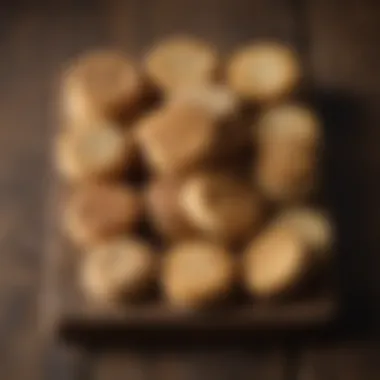
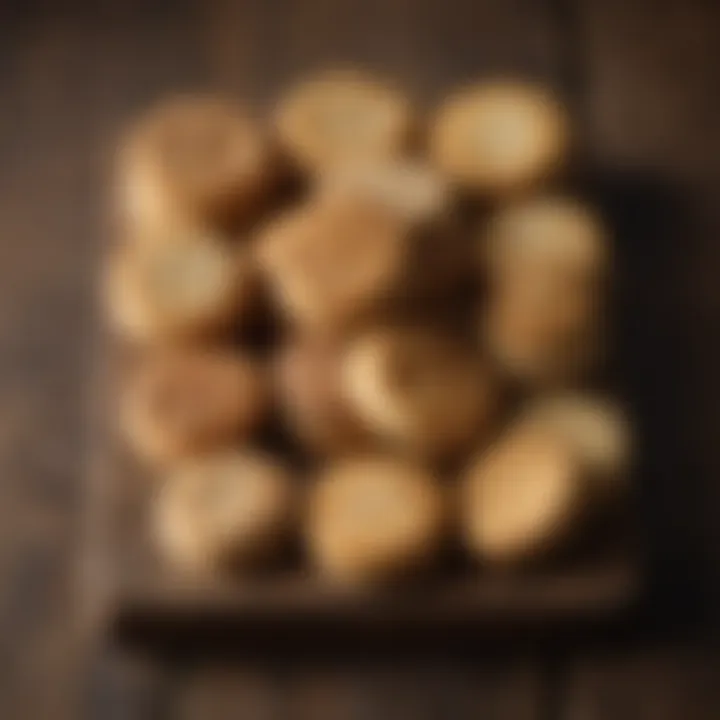
- Flour: All-purpose flour serves as the backbone. Its gluten content affects the biscuit's structure. Choosing the right flour can significantly impact biscuit texture; a lower gluten flour will produce a tender product.
- Fat: Butter is not just a flavor enhancer. It helps create layers in flaky biscuits. The fat coats flour proteins, limiting gluten formation, which leads to a more tender result.
- Liquid: Milk or water hydrates the flour and activates the leavening agents. Adding liquid gradually is key to controlling dough consistency.
- Leavening Agents: Baking powder or baking soda are essential for expansion during baking. Knowing how each works helps in adjusting recipes based on altitude or humidity.
A clear understanding of these ingredients brings greater confidence to bakers.
The Science of Fat in Baking
Fat plays an integral role in biscuit making. Besides flavor, fat increases richness and overall sensory experience. The method of incorporating fat can shape the resulting product. Different techniques such as cutting the butter into flour versus melting it lead to different textures.
There are several benefits to using fat:
- Flavor: Fat carries flavors effectively, enhancing the overall taste profile.
- Texture: Butter creates space in dough, which results in flakiness.
- Moisture Retention: Fat traps moisture within the biscuit, maintaining tenderness even after baking.
Understanding fat's functionality not only informs preparations but also helps in troubleshooting if the final product doesn't turn out as expected.
Choosing Quality Butter
When it comes to butter, not all options are alike. High-quality butter supports superior biscuit quality. Factors to consider when choosing butter include:
- Fat Content: Select butter with a higher fat content, around 82% or above is optimal for a richer end product.
- Unsalted vs. Salted: Consider using unsalted butter for better control over salt levels in your dough, especially if using baking powder that may already contain salt.
- Freshness: Utilize plain butter rather than spreadable versions which may contain additives or oils, compromising the biscuit’s flavor.
- Source: Sustainable and organic options may provide enhanced flavor and detailed profile. Seek local dairies where possible, as fresh ingredients make a notable difference.
By prioritizing these factors in selection, bakers should aim to create biscuits that not only meets their expectations but surprises them too. Achieving pleasant results begins with the right ingredients.
Essential Biscuit Recipes Using Butter
Butter plays a significant role in creating a wide lineup of biscuit recipes. The richness and moisture from butter elevate textures and flavors distinctly. This section outlines classic recipes and various innovations, showcasing how to incorporate butter into different styles of biscuits to result in satisfying baked goods. From tradition to modern twists, these recipes are central to mastering biscuit making.
Classic Butter Biscuits
Classic butter biscuits offer simplicity with rich flavor. The base consists of butter, flour, sugar, and milk. A good quality unsalted butter should be used to control the saltiness.
- Begin by creaming softened butter with sugar until mixture is light.
- Gradually add flour, mixing continuing till just combined.
- Chill the dough. Shapes can then be made either by cutting or rolling.
- Bake until lightly golden. This yields a biscuit that melts pleasantly in the mouth, with a lightly crisp outer layer.
Herbed Butter Biscuits
Herbed butter biscuits introduce an aromatic twist. Incorporating fresh herbs adds depth. Different herbs like rosemary, dill, or thyme can even be used alone or in combination.
- Mix chopped herbs into creamed butter before adding flour.
- For additional flavor, a pinch of garlic powder often enhances profile.
- The variability of herbs allows each batch to be distinct while still relying on the butter’s richness.
The end product is a savory biscuit that complements soups or serves as an appetizer. Cozy and fragrant, these are perfect for gatherings.
Cheddar and Butter Biscuits
Cheddar and butter biscuits combine savory cheese and rich butter. This combination creates a satisfying indulgence.
- Grate sharp cheddar and mix it with flour.
- Then, fold in cubed cold butter until crumbly.
- Add milk slowly, observing dough consistency for shaping.
The dough should be flaky yet buttery. This achieves high flavor next to a variety of sauces or with just plain butter. Pair these with a hearty soup for a well-rounded meal.
Sweet Butter Biscuits
Sweet butter biscuits skirt a fine line between dessert and breakfast. Using brown sugar can give a deeper flavor.
- Incorporate Vanilla extract for aromatic enhancement.
- Chocolate chips can be added for surprised sweetness.
These biscuits work neatly with fruit preserves or ice cream for an enjoyable sharing experience. Consistency here should allow easy spreading, light yet moist texture keeps delight readily present.
In summary, each recipe here celebrates butter in various capacities highlighted throughout—and addresses unique flavors from classic heritage to innovative joys. The addition of butter significantly affects taste and textural experience with biscuits. The fundamental nudge towards creativity rests as fresh homemade treats often run surplus on charm amongst family and friends.
Techniques for Making Perfect Biscuits
To achieve excellence in biscuit baking, mestering the right techniques is crucial. Proper methods can transform a simple recipe into something truly special. Three key areas will be covered: mixing techniques, cutting and shaping, and finally, baking and timing guidelines. Each area plays a vital role in refining the texture, shape, and flavor of biscuits.
Mixing Techniques for Optimal Texture
Mixing is a critical step in biscuit making. It is not just about combining ingredients, but about creating the right texture. Overmixing can develop gluten, which leads to dense biscuits, while undermixing can cause poor dough structure. Finding the balance is essential.
- Use cold ingredients: Cold butter ensures that it doesn’t melt into the dough before baking. This helps keep pockets of air within biscuits, creating a flakier texture.
- Gentle folding: When incorporating dry ingredients, gently fold them together instead of stirring vigorously. This minimizes gluten development.
- Use the right tools: A pastry cutter or fork is effective for cutting butter into the flour. This prevents warming the fat and retains the desired texture.

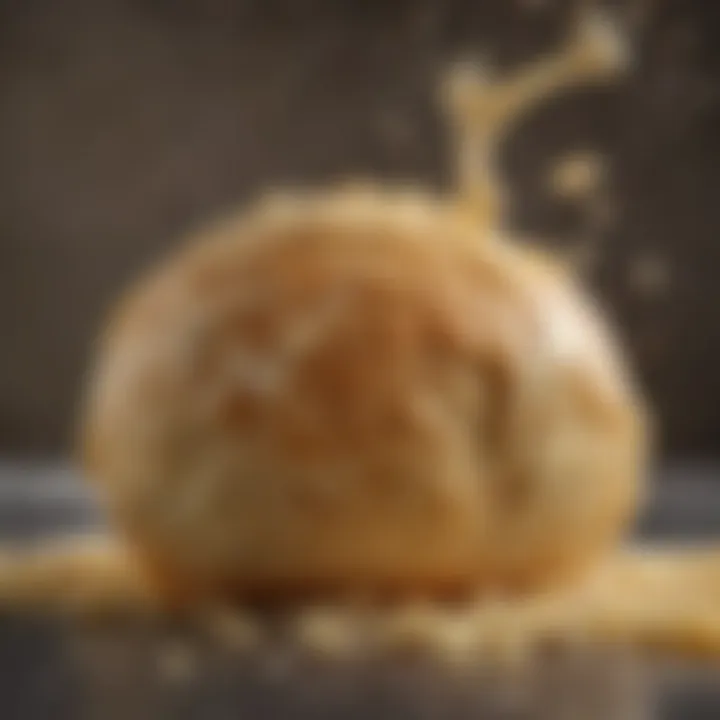
Following these techniques ensures an optimal mixing process that produces biscuits that are both fluffy and flavorful.
Cutting and Shaping Biscuits
The way biscuits are cut and shaped can greatly influence their final appearance and texture. Using the proper technique not only affects looks but also determines how the biscuits rise in the oven.
- Use a sharp cutter: A sharp, floured cutter ensures clean edges that help biscuits rise evenly. A dull cutter can compress the dough, hindering buildup of air.
- Don't twist the cutter: Twisting the cutter while cutting can seal off the edges, limiting proper rising. Just press straight down and lift.
- Shape with finesse: For free form biscuits, use your hands to gently shape the dough into circles or squares. Evenness in size makes for more consistent baking.
Taking care in the cutting and shaping leads to aesthetically pleasing and evenly baked biscuits.
Baking and Timing Guidelines
Baking properly is where many bakers see the most variation in outcomes. There are crucial factors regarding oven temperature and timing essential for perfect biscuits.
- Preheat the oven: Preheating ensures that the hot air circulates evenly and biscuits can rise correctly. Each recipe may vary, but an oven temperature between 400°F to 425°F typically works best.
- Position matters: Place biscuits in the center of the oven to achieve even heating. If not sure, you can rotate them halfway through baking.
- Check for doneness: Biscuits typically bake in about 12 to 15 minutes. Keep an eye on them; they should turn golden brown on top. Perhaps try one option using the toothpick test— if it comes out clean they are ready.
Following these timings and baking specifications will result in grains that lift and become downright irresistible.
Proper techniques are the foundation of successful biscuit baking. Pay attention to each step to ensure delightful results.
In summary, mastering techniques for mixing, cutting, and baking can significantly elevate your biscuit-making skills. Results will reflect effort and understanding applied throughout the process, yielding biscuits everyone will cherish.
Biscuit Variations and Customizations
Exploring biscuit variations and customizations can dramatically enhance your baking experiences. By incorporating unique elements into your recipes, you can cater to diverse tastes and preferences, ensuring that your biscuits stand out. This section will cover several ways to elevate your biscuits, whether through seasonal ingredients, alternative dietary options, or different flavors.
Incorporating Seasonal Ingredients
Seasonal ingredients can greatly influence the taste and freshness of your biscuits. From fruits in spring to spices in autumn, each season brings various options that can transform a basic recipe into something special.
- Fruits: Consider adding peaches or blueberries during the summer months for a fruity twist.
- Herbs: In spring, herbs like chives or basil can provide a subtle but engaging flavor profile.
- Spices: In fall and winter, spices such as cinnamon cloves can evoke cozy feelings, enhancing sweet biscuit recipes.
- Vegetables: Experiment with things like zucchini or pumpkin in other seasons for a nutritious upgrade.
Emphasizing seasonal ingredients not only elevates the taste but also aligns your baking with local produce availability.
Gluten-Free Biscuit Options
Gluten-free baking presents another level of customization. With a growing emphasis on gluten-free diets, offering this option in your biscuit repertoire can appeal to a broader audience.
Popular gluten-free flours:
- Almond flour: Brings a nutty flavor and moist texture.
- Coconut flour: Very absorbent; should be mixed with other flours for best results.
- Rice flour: Offers a neutral flavor, making it easy to blend with other ingredients.
When making gluten-free biscuits, pay attention to mix inclusions. Additional binding agents like xanthan gum might be needed to mimick gluten's effects.
Savory vs.
Sweet Adaptations
When considering flavor profiles, select between savory and sweet adaptations of your biscuits. Both options have their merits and place in different occasions.
Sweet Biscuits
Sweet biscuits usually include sugar and may also have flavorings like vanilla or chocolate. These are generally served as snacks or for breakfast. Some frequent variations include:
- Chocolate chip biscuits
- Lemon shortbread biscuits
- Cinnamon roll biscuits
Savory Biscuits
Savory variants often combine cheese, herbs, or spices for rich flavors. They can serve as wonderful accompaniments to soups or stews. Examples include:
- Buttermilk cheddar biscuits
- Garlic and rosemary biscuits
- Cheddar jalapeño biscuits
Understanding the differences between sweet and savory allows you to tailor your baking to fit any meal or occasion.
Using bisquit customization not just opens up numerous flavor profiles but ensures more diverse taste preferences can be met.
As you can see, variations and customizations offer exciting opportunities in biscuit making. Embrace creative experimentation to widen your baking skills and present unique offerings.
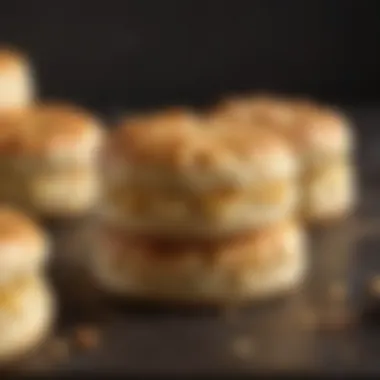
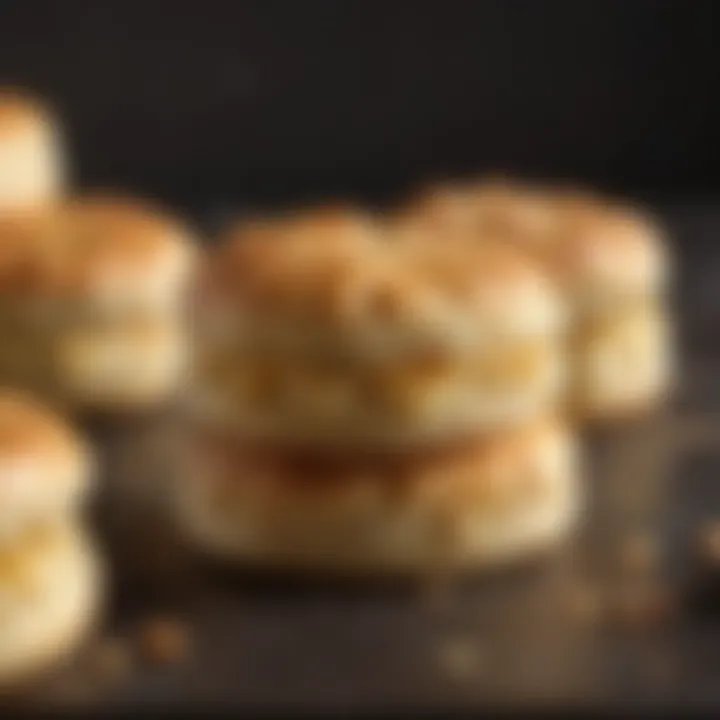
Practical Tips for Busy Bakers
Baking biscuits can be both a satisfying and a time-consuming process. For those with a busy schedule, practical tips become invaluable. Implementing smart strategies can lessen the overall effort involved, while ensuring delicious outcomes. It allows you to enjoy home-baked goods without significant time investment.
Time-Saving Baking Strategies
Efficient baking starts with planning. Choose recipes that require fewer steps and ingredients. For instance, simple butter biscuits often include minimal components, yet deliver great taste. Familiarize yourself with common recipes. This shortens prep time as you know what to expect.
Consider preparing dough ahead of time. You can mix the ingredients and refrigerate them until you're ready to bake. As the butter solidifies, this also aids in achieving the best texture during baking.
Additionally, prioritize to-use utensils clean up. Keep your workspace organized by gathering all needed items before starting. This approach streamlines the baking process, allowing focus on the task.
Batch Cooking and Freezing Biscuits
Batch cooking is an effective way to ensure you have fresh biscuits ready whenever you need them. Depending on the recipe, you can either freeze unbaked dough or the finished product.
To freeze unbaked dough:
- Shape the biscuits and place them on a baking sheet.
- Put the tray in the freezer until the biscuits are firm, then transfer them to a freezer bag. Staying frozen, they can be baked directly from the freezer. So convenience does take the forefront without losing flavor or texture.
For already baked biscuits, let them completely cool. Once cooled, store them in airtight containers or wraps. Choose low humidity environments for the best results.
Storing and Reheating Biscuits
Proper storage is critical to keep biscuits fresh. Biscuits can lose their texture overnight due to moisture. For immediate consumption, place biscuits in a closed container. If you'll keep them longer than two days, it's recommended to freeze them.
To reheat leftovers:
- Preheat your oven to 350°F.
- Spread the biscuits onto a baking sheet.
- Warm for 5-10 minutes until they regain their warmth and slight crispness.
Remember: Avoid microwaving unless necessary, as they typically become rubbery lacking crunch.
In summary, adopting these practical strategies lets busy bakers achieve the joy of homemade biscuits without overwhelming time commitments. With thoughtful approaches, time can be managed more effectively while still achieving delicious results.
Common Biscuit-Baking Mistakes
In any kitchen, mistakes in biscuit baking can lead to disappointing results. Identifying and addressing the common pitfalls in the process enhances the final product's texture and flavor. Whatever the baking experience level, this section is dedicated to shedding light on these missteps, so bakers confidently create better biscuits. Understanding potential errors can lead to improved knowledge and skill, making baking a more enjoyable experience.
Overworking the Dough
One of the most significant errors in biscuit-making is overworking the dough. When that happens, gluten develops more than desired. This results in tough rather than tender biscuits. Ideally, biscuit dough should be handled minimally. After combining the ingredients, the dough should just come together. Select an appropriate mixing approach, typically by incorporating ingredients swiftly.
The balance is crucial: mix enough to ensure cohesion but do not go beyond. Remember, every fold and turn tightens the dough. Aim to stop mixing as soon as no dry flour exists. If the recipe specifies blending only until combined, trust it. Instead of the desire to achieve a smooth surface, prioritize achieving a crumbly texture, as that is a good sign of proper dough preparation.
"Handle the dough lightly; less is more when striving for a flaky biscuit."
Taking time to rest the dough can help in achieving optimal results. Letting it rest permits the gluten to relax, producing a superior texture during baking. Use this strategy to ensure biscuits emerge light and flakey from the oven rather than dense and hard.
Incorrect Oven Temperature
Another grave error happens when bakers misjudge the oven temperature. For perfect biscuits, accurate and preheated ovens make a significant difference. If the temperature is too low, biscuits may spread rather than rise. Conversely, if the oven runs hot, the edges can brown while the interior remains uncooked.
Using an oven thermometer can help track the heating accuracy. Most ovens do not offer complete reliability concerning temperature settings. Most recipes give hints for typical baking times, often calling for around 425°F. However, every oven comes with unique heat dynamics. Careful observation and calibration could positively affect the baking outcome.
It's useful to understand the visual indicators as well. Ideal biscuits will show a lightly golden top, with a consistent puff throughout. Lack of rising indicates either lower temperatures or dough mishandling. This self-assessment can guide ways to adapt approaches based on various factors, creating an individualized baking experience.
Baking biscuits may seem simple on the surface. Nonetheless, addressing these frequent mistakes could lead to delightful, satisfying results creatively.
Ending
Mastering biscuit recipes with butter carries significant importance, as this ingredient is essential in crafting a range of biscuit forms that are both tender and flavorful.
The role of butter in biscuit making summarizes many broader themes discussed throughout this article. The acute attention to ingredients, mixing techniques, and practical baking tips converge towards one goal: achieving the perfect biscuit. Butter elevates flavor, enhances textures, and contributes to the golden-brown color that appeals to any eater. It provides moisture, richness, and flakiness when properly incorporated into the dough.
Key Elements of Conclusion:
- Flavor and Texture: Using high-quality butter leads to much richer flavors and superior textures. Readers explored the differences in biscuits created with various alternatives.
- Versatility: From classic biscuits to innovative seasonal varieties, butter provides an adaptability that few other fats can echo. This flexibility supports creativity in the kitchen while allowing for personal preferences.
- Common Mistakes: Authors delved into frequent pitfalls that bakers encounter. By recognizing mistakes like overworking dough, readers can avoid common errors that lead to frustrating results.
- Customization: With tips provided, including incorporating different herbs, cheeses, or flavor adaptations, each reader can cater their baking to specific tastes and dietary needs.
“Baking is both science and art. Mistakes can often lead to astonishing discoveries, but fundamentals like quality butter are key to executing skillful creations.”
Ultimately, this guide empowers the busy bakers within our target audience. Practical strategies will enable swift baking without sacrificing quality. By remembering the insights, flavor nuances, and customizable aspects, anyone can create delightful biscuit variations that enhance gatherings or treat loved ones.
Checking temperature, understanding fat science, and acknowledging the individuality of biscuit preferences prepare a base for confident baking. Anyone can now go beyond mere recipes and masterfully craft biscuits that invite enjoyment for the shared moments spent tasting them.







